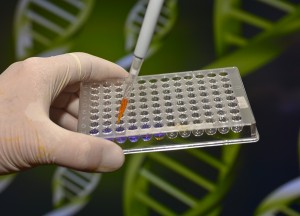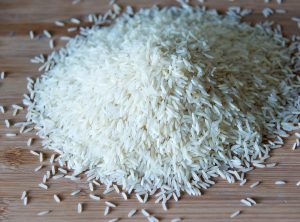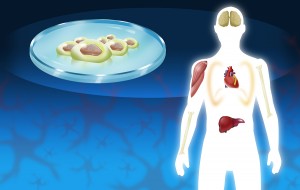Dr. Matt Pratt-Hyatt gave an overview about genetic screening for better health at the 23rd Annual World Congress on Anti-Aging Medicine on Dec. 13, 2015 in Las Vegas. The title of the talk was: ”Genetic Screening: A Tool for Better Health with Age”. He showed that with more sensitive genetic screening techniques minor genetic changes can be detected. These are a lot more common than previously thought of. Matt Pratt-Hyatt, PhD is Associate Laboratory Director for the Great Plains Laboratory in Lenexa, KS.
Specifically, Dr. Pratt-Hyatt explained that single nucleotide polymorphisms, frequently called SNPs (pronounced “snips”) were the most common type of genetic variations among people. These genetic changes in the DNA often cause disease. Different types of genetic testing can identify the gene defects of SNPs. One of the questions is how aging can be better managed when genetic defects are known.
When it comes to our genetic material there are over 3 billion base pairs, all contained in 23 chromosomes. These are home to 20,000-25,000 genes, most of which are normal.
A gene has three regions all of which can have mutations. In the middle there is the coding region; one end is the regulatory region for transcription initiating; at the other end the transcription termination signals are located. Minor mutations in any of these regions can have major implications for the health of the individual or they can stay silent SNPs. SNPs are classified into missense mutation or nonsense mutation. This description just shows how intricate and complex the process of mutations can be!
There are three types of sequencing that are common:
Three types of genetic screening for better health
- Sanger sequencing utilizes certain dyes that correspond to specific nucleotides of the DNA. The benefits of Sanger sequencing is that it can cover one gene completely. It can find previously unknown mutations. But the disadvantage of Sanger sequencing is that you cannot process a large number of genes.
- The Florophore-base detection looks at multiple SNPs in a single run. This method is cheaper than whole genome sequencing. But one of the disadvantages of Florophore-base detection is that only a limited number of SNPs can be processed per run. It also can miss new mutations.
- Benefits of next generation sequencing are that it can look at 1000s of SNPs per run. It is much more accurate than previous technologies. A drawback though is that the equipment is much more expensive.
The physician does not have to order all of these tests, but can make the choice of the appropriate one for the patient. The following are some applications with regard to how genetic screening can be useful for better health.
Detoxification as part of genetic screening for better health
Since the 1970’s and 1980’s it has become clear that there are many steps in the detoxification process in the liver. It involves major enzyme systems that are controlled by the P450 genes. We know several genetic defects that run in different families. These effects are very important for drug detoxification and metabolism.
The P450 detoxification system in the liver
Any mutation in one of the P450 controlling genes will lead to accumulation of the drug that is normally detoxified by this enzyme system. Without discontinuing or lowering the drug there can be toxicity at higher levels. When people age, they often have spontaneous mutations of the P450 detoxification system. The physician who prescribes medications should take this into account. Common drugs that cause problems with the P450 controlled detoxification are antidepressants, the blood thinner Coumadin, the antibiotic erythromycin, the asthma medication Theophylline and many others.
Patient with atrial fibrillation
Here is an example of how important this knowledge is in an elderly patient who was sent to the hospital with an irregular heartbeat. The electrocardiogram allowed a diagnosis of atrial fibrillation. The doctor treated the patient with a cautious loading dose of 0.5 mg of Coumadin in an attempt to thin the blood of the patient. This would prevent a blood clot or a stroke due to the arrhythmia. Normally a small dose like this would not do much in terms of blood thinning. It would take several days of small doses of Coumadin dose like this to achieve blood thinning.
Defect of gene controlling P450 system
Unbeknown to the physician, this patient was different as he had a defect in the Cyp2c9 gene, a subtype of the P450 system. Very quickly the patient developed bleeding gums and bruising of the skin in various locations. When blood tests were taken, the INR, a measure of the clotting system, was 3.7, a value that should not have exceeded a level of 2 to 3. Genetic testing confirmed a homogenous mutation of the Cyp2c9 gene that explained the toxicity of Coumadin in this case, one of the many drugs that is detoxified by the P450 system.
Mental health as part of genetic screening for better health
Many mental illnesses can be caused by defects in various parts of the brain metabolism. This is particularly so when it involves the synthesis of brain hormones. If there are genetic defects, this can lead to the particular brain metabolism that is associated with depression or schizophrenia. Even dementia, Alzheimer’s disease and Parkinson’s disease can be caused by genetic defects. Methylation pathway defects are another source of possible genetic defects, which can affect multiple metabolic pathways. This is the cause of many diverse conditions like autism, diabetes and some hereditary cancers. The reason it is important to be aware of such genetic aberrations is that often vitamin B2, B6, niacin, vitamin B12 and the minerals magnesium and zinc can stabilize a person with methylation defects.
Cholesterol as part of genetic screening for better health
People with obesity have problems with their lipid metabolism, diabetes, high blood pressure and often heart disease and strokes. Changes in cholesterol metabolism are at the center of these problems. Cholesterol is one of the building blocks of cell membranes, and cholesterol is one of the normal components in the blood as long as the subfractions are properly balanced (LDL and the HDL cholesterol). Unfortunately many people have minor or major defects of the biosynthetic pathway of cholesterol. There are 5 genes that control the acetyl CoA biosynthesis. 21 genes involve the main cholesterol biosynthesis pathways. Over 10 genes control cholesterol metabolites. Historically these genes were detected because of various familiar gene defects that caused problems with the biochemical processes surrounding cholesterol. Familial high cholesterol levels (familial hypercholesterolemia) is one of these common conditions.
Patients who have this condition will often have high cholesterol and also often have a family history of gall bladder surgery for gallstones and a history of premature heart attacks or strokes. Early diagnosis and careful clinical intervention can improve the outlook for many patients.
Conclusion
Modern medicine cannot help all of the genetic conditions. But you can work around many minor genetic abnormalities. In addition, if the physician knows the genetic defect, it is possible to avoid drug interactions. It is encouraging that newer test methods have now shown success, as they are more affordable than in the past. As time progresses the price of these genetic tests will come down even further. Mental health, detoxification pathways and the metabolic syndrome of obesity are practical applications where genetic tests have significance.















